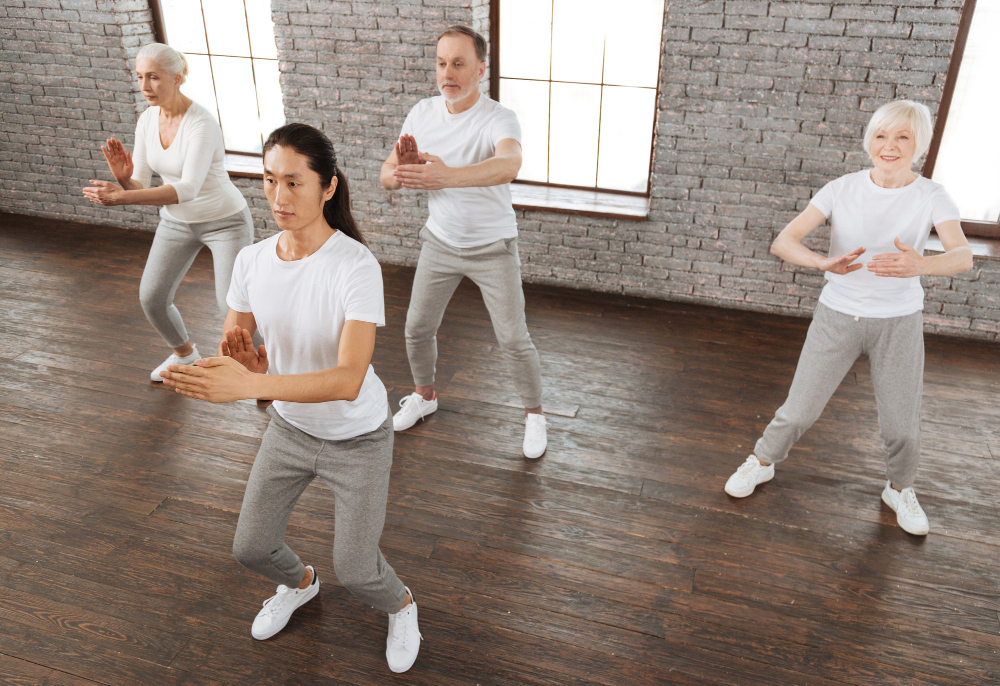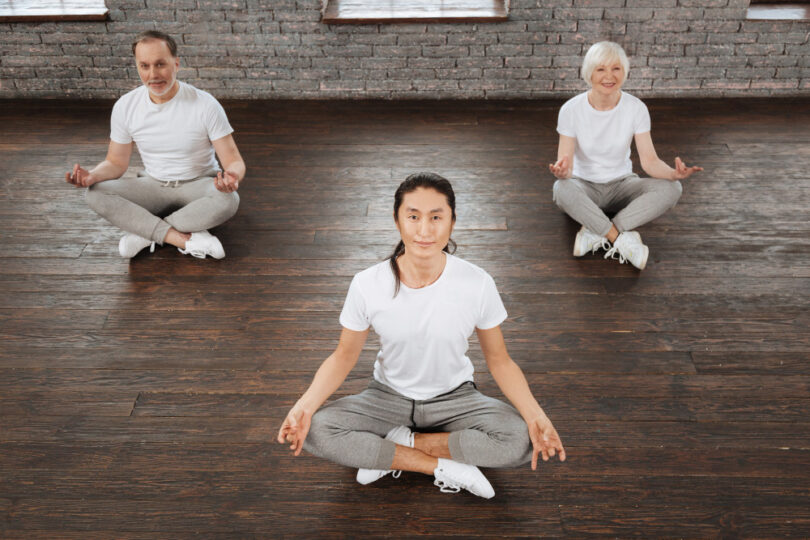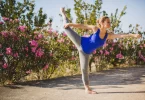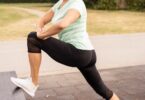Table of Contents
Introduction
Yoga is more than just a fitness trend; it’s a lifestyle choice that brings numerous benefits to both body and mind. For adults, yoga classes offer a sanctuary from the hustle and bustle of daily life, providing a space to unwind, stretch, and rejuvenate. Whether you’re a seasoned yogi or a complete beginner, adult yoga classes can cater to your needs and help you achieve your wellness goals.
The Benefits of Adult Yoga Classes
Physical Benefits
Yoga offers a multitude of physical benefits that can enhance your overall health and well-being.
Improved Flexibility
One of the most celebrated benefits of yoga is improved flexibility. Regular practice stretches and lengthens muscles, which can help alleviate physical discomfort and prevent injuries.
Regular practice stretches and lengthens muscles, helping to alleviate physical discomfort and prevent injuries. For more insights on enhancing flexibility, explore Yoga Poses for Flexibility.
Enhanced Strength
Yoga isn’t just about stretching; it’s also about building strength. Many poses require you to support your own body weight in new ways, which can build muscle tone and endurance.
Many poses require you to support your own body weight in new ways, building muscle tone and endurance. Discover The Importance of Yoga in Our Life for further understanding of how yoga strengthens the body.
Better Balance
Many yoga poses focus on balance, helping to improve your stability and coordination. This is particularly beneficial for adults as it can help prevent falls and improve overall physical confidence.
Mental Benefits
Beyond the physical, yoga offers profound mental benefits that can significantly improve your quality of life.
Stress Reduction
Yoga is a powerful tool for managing stress. The combination of physical movement, breathing exercises, and meditation helps to calm the mind and reduce anxiety.
Improved Focus
Practicing yoga requires concentration and mindfulness, which can enhance your ability to focus in other areas of your life.
Better Sleep
Regular yoga practice has been shown to improve sleep quality. The relaxation techniques used in yoga can help you unwind and prepare your body for a restful night’s sleep.
Types of Yoga for Adults
Certainly! Here are some popular types of yoga for adults:
1. Hatha Yoga
- Description: A general term for any type of yoga that teaches physical postures. Typically, a Hatha class is a slow-paced stretching class with some simple breathing exercises and possibly seated meditation.
- Benefits: Great for beginners as it offers a gentle introduction to the basic yoga postures.
- A great starting point for beginners, involving basic postures and breathing exercises, focusing on alignment and relaxation. For a comprehensive guide, visit Creating a Yoga Practice.
2. Vinyasa Yoga
- Description: Known for its fluid, movement-intensive practices. A Vinyasa class typically features a series of poses that flow smoothly into one another, synchronized with breath.
- Benefits: Enhances flexibility, strength, and cardiovascular fitness.
3. Ashtanga Yoga
- Description: A rigorous style of yoga that follows a specific sequence of postures and is similar to vinyasa yoga, but faster-paced and more physically demanding.
- Benefits: Builds core strength and toning the body. It’s ideal for those looking for a physically demanding workout.
4. Iyengar Yoga
- Description: Focuses on alignment and precise movements. Practitioners often use props such as belts, blocks, and wall ropes.
- Benefits: Good for building strength and improving body alignment. Suitable for those recovering from injuries.
5. Bikram Yoga
- Description: Also known as hot yoga, this practice consists of a series of 26 challenging poses performed in a room heated to approximately 105°F (40°C).
- Benefits: Promotes detoxification and flexibility. However, it can be intense and may not be suitable for everyone.
6. Kundalini Yoga
- Description: Combines postures, breathing exercises, and chanting to awaken the kundalini energy located at the base of the spine.
- Benefits: Enhances spiritual growth and mindfulness. It’s great for those looking for a more meditative approach.
7. Yin Yoga
- Description: A slow-paced style of yoga with poses that are held for longer periods of time, typically 3 to 5 minutes.
- Benefits: Improves flexibility and joint mobility. It’s very relaxing and meditative.
8. Restorative Yoga
- Description: Similar to Yin, it focuses on relaxation and healing the body. Poses are typically held for a long time, and props are used to support the body.
- Benefits: Reduces stress and promotes relaxation. Ideal for recovery and relaxation.
- Focuses on relaxation and recovery with gentle stretches and long holds, often supported by props, to release tension. Check out Restorative Yoga for Seniors for more on this relaxing practice.
9. Power Yoga
- Description: A vigorous, fitness-based approach to vinyasa-style yoga. Power yoga aims to build strength and flexibility.
- Benefits: Enhances strength, flexibility, and stamina. Good for those looking for a high-energy workout.
10. Anusara Yoga
- Description: Focuses on alignment but also encourages opening the heart and celebrating the body’s capabilities.
- Benefits: Promotes physical health and emotional well-being. It’s inclusive and welcoming for practitioners of all levels.
11. Sivananda Yoga
- Description: A classical form of yoga that follows a set structure including breathing exercises, a series of 12 basic postures, and relaxation techniques.
- Benefits: Balances body and mind, promoting a healthy lifestyle and holistic well-being.
These different styles cater to various fitness levels and preferences, allowing individuals to choose the one that best fits their needs and goals.
Choosing the Right Yoga Class
Choosing the right yoga class can significantly enhance your experience and ensure you get the most out of your practice. Here are some tips to help you select the best yoga class for your needs:
1. Identify Your Goals
- Fitness: If your primary goal is to improve physical fitness, you might enjoy more vigorous styles like Vinyasa, Ashtanga, or Power Yoga.
- Flexibility and Relaxation: To improve flexibility and relaxation, consider Hatha, Yin, or Restorative Yoga.
- Spiritual Growth: If you’re looking for a spiritual connection, Kundalini or Sivananda Yoga might be more suitable.
- Recovery and Alignment: For those recovering from an injury or looking to improve body alignment, Iyengar Yoga is a great option.
2. Assess Your Fitness Level
- Beginners: If you’re new to yoga, start with beginner-friendly classes like Hatha or Gentle Yoga to learn the basic poses and breathing techniques.
- Intermediate/Advanced: If you have some experience, you might enjoy more challenging classes like Vinyasa, Ashtanga, or Power Yoga.
3. Consider Your Physical Condition
- Injuries or Health Conditions: If you have any injuries or health conditions, consult with your doctor and choose classes that are gentle and focused on healing, such as Restorative or Iyengar Yoga.
- Pregnancy: Prenatal Yoga classes are specifically designed for pregnant women and can be very beneficial.
4. Think About the Class Environment
- Temperature: Some yoga classes, like Bikram or Hot Yoga, are held in heated rooms. Ensure you are comfortable with high temperatures before choosing these classes.
- Class Size: Smaller classes often provide more personalized attention, which can be beneficial for beginners or those with specific needs.
5. Check the Instructor’s Credentials
- Qualified Instructors: Ensure that the instructor is certified and has adequate experience, especially in the type of yoga you are interested in.
- Teaching Style: Attend a trial class to see if the instructor’s teaching style resonates with you. Some instructors focus more on alignment and detail, while others may emphasize flow and energy.
6. Location and Schedule
- Convenience: Choose a class location that is convenient for you to ensure regular attendance.
- Timing: Select a class time that fits well into your daily routine, whether it’s early morning, lunchtime, or evening.
7. Cost and Membership Options
- Budget: Consider your budget and look for classes or memberships that offer good value for money. Some studios offer introductory deals for new members.
- Online vs. In-Person: Decide whether you prefer the convenience of online classes or the community and hands-on adjustments of in-person classes.
8. Personal Preferences
- Music and Atmosphere: Some classes incorporate music, while others may focus on silence and meditation. Choose based on your personal preference.
- Props and Equipment: If you prefer using props for support, look for classes like Iyengar or Restorative that integrate these tools.
9. Trial and Error
- Experiment: Don’t be afraid to try different types of yoga and various instructors until you find what works best for you.
- Feedback: Pay attention to how you feel after each class. The right class should leave you feeling energized, balanced, and looking forward to your next session.
By considering these factors, you can find a yoga class that aligns with your goals, fitness level, and preferences, ensuring a fulfilling and enjoyable practice.

What to Expect in an Adult Yoga Class
Attending an adult yoga class can be a rewarding experience that offers numerous physical and mental benefits. Here’s what you can typically expect:
1. Arrival and Setup
- Arrive Early: Arrive 10-15 minutes before the class starts to sign in, set up your mat, and get comfortable.
- Materials: Bring a yoga mat, a water bottle, and a towel. Some studios provide mats and props, but it’s good to check beforehand.
- Props: You may encounter props like blocks, straps, blankets, and bolsters, which can aid in your practice.
2. Class Environment
- Atmosphere: The yoga studio is usually a calm and serene space, often with dim lighting and soothing music.
- Community: Classes can vary in size. You’ll likely find a diverse group of participants, from beginners to experienced yogis.
3. Instructor Introduction
- Greeting: The instructor will typically introduce themselves, outline the class structure, and ask if anyone has injuries or special needs.
- Guidance: They may offer adjustments or modifications for different skill levels and physical conditions.
4. Warm-Up
- Gentle Stretching: Classes often begin with gentle stretching to warm up the body and prepare for more intense postures.
- Breathing Exercises: Expect to practice breath control (pranayama) to center your mind and body.
5. Main Practice
- Sequence of Poses: The main part of the class will involve a sequence of yoga poses (asanas). The type and intensity of poses depend on the style of yoga you’re practicing.
- Hatha: Focus on basic postures with an emphasis on alignment and breath.
- Vinyasa: A continuous flow of poses synchronized with the breath.
- Ashtanga: A set sequence of poses with a focus on strength and flexibility.
- Yin/Restorative: Long-held, passive poses for deep stretching and relaxation.
- Instructor Cues: The instructor will guide you through each pose, offering cues for proper alignment and breathing.
6. Adjustments and Modifications
- Hands-On Adjustments: Instructors may offer hands-on adjustments to help you deepen a pose or correct alignment.
- Modifications: Modifications for poses are provided to accommodate different fitness levels and physical limitations.
7. Cool Down
- Gentle Poses: The class will wind down with gentle poses to help the body relax and transition out of the practice.
- Breathing and Meditation: Often includes focused breathing exercises and meditation to calm the mind.
8. Savasana (Corpse Pose)
- Relaxation: The class typically ends with Savasana, a resting pose where you lie on your back with eyes closed, allowing your body and mind to fully relax.
- Duration: This pose usually lasts for 5-10 minutes and is essential for integrating the benefits of the practice.
9. Closing
- Final Words: The instructor may offer some closing thoughts or a short meditation.
- Namaste: Classes often conclude with a communal “Namaste,” a respectful greeting or farewell.
10. Post-Class
- Hydration and Rest: It’s important to drink water and rest after class to allow your body to recover.
- Reflection: Take a moment to reflect on your practice and how you feel.
Additional Tips
- Comfortable Clothing: Wear comfortable, breathable clothing that allows for a full range of motion.
- Footwear: Yoga is typically practiced barefoot.
- Listen to Your Body: It’s important to listen to your body and not push beyond your limits. Yoga is about finding a balance between effort and ease.
- Ask Questions: Don’t hesitate to ask the instructor questions before or after class if you need clarification on poses or modifications.
By knowing what to expect, you can approach your yoga class with confidence and an open mind, ready to enjoy the many benefits of this ancient practice.
FAQs
What are the 5 Major Types of Yoga?
Hatha Yoga
Description: A gentle introduction to the most basic yoga postures. It involves a slower pace and simpler poses.
Benefits: Ideal for beginners, improves flexibility, strength, and balance.
Vinyasa Yoga
Description: Involves a series of poses that flow smoothly into one another, synchronized with breath.
Benefits: Enhances cardiovascular fitness, flexibility, and strength.
Ashtanga Yoga
Description: A rigorous style of yoga that follows a specific sequence of postures is known for its fast pace and intensity.
Benefits: Builds core strength and stamina and improves flexibility and muscle tone.
Iyengar Yoga
Description: Focuses on alignment and precise movements, often using props such as belts, blocks, and wall ropes.
Benefits: Perfects posture, enhances body alignment, and is suitable for injury rehabilitation.
Bikram Yoga
Description: Also known as hot yoga, this practice consists of 26 challenging poses performed in a room heated to approximately 105°F (40°C).
Benefits: Promotes detoxification, flexibility, and cardiovascular health.
What is the Most Popular Yoga Class?
Vinyasa Yoga is considered the most popular yoga class due to its dynamic and fluid style. It appeals to a wide range of practitioners, from beginners to advanced, and can be easily modified to suit different fitness levels.
Is There an Age Limit for Yoga?
There is no strict age limit for practicing yoga. Yoga can be adapted to suit all ages and fitness levels, from children to seniors. However, certain styles and intensity levels may be more suitable for specific age groups or individuals with particular health considerations. It’s important to consult with a healthcare provider before starting any new exercise regimen, especially for older adults or those with pre-existing health conditions.
What are the Age Groups for Yoga?
Children (4-12 years)
Focus: Fun, engaging poses, and breathing exercises.
Benefits: Improves flexibility, concentration, and body awareness.
Teens (13-18 years)
Focus: Building strength, flexibility, and managing stress.
Benefits: Enhances physical fitness, emotional stability, and self-esteem.
Adults (19-64 years)
Focus: A variety of styles depending on fitness goals (e.g., Vinyasa for fitness, Hatha for relaxation).
Benefits: Improves overall health, reduces stress, enhances flexibility, and builds strength.
Seniors (65+ years)
Focus: Gentle yoga practices such as Hatha, Iyengar, or chair yoga.
Benefits: Enhances mobility, balance, and joint health, and provides a gentle way to stay active.
By understanding these aspects of yoga, individuals can choose the most suitable practice for their age, fitness level, and personal goals.
Conclusion
Adult yoga classes offer a wealth of benefits for both the body and mind. From improved flexibility and strength to stress reduction and better sleep, yoga can enhance your overall quality of life. Whether you’re a beginner or an experienced practitioner, there’s a class out there for you. So grab your mat, find a class that suits your needs, and start your yoga journey today!
Related Article:







